Since I finished 135 books in 2019, I decided to review my top 10%.
I confess that I did review a few books, which I didn’t fully complete. This always leaves me torn because I do not list them on my “read” list for a given year. Thus, a book that I haven’t finished reading might appear on another year’s list, since I completed it after my official review.
These are in no particular order:
 Burnout: The Secret to Unlocking the Stress Cycle
Burnout: The Secret to Unlocking the Stress Cycle
I did review Burnout here. This book sticks with me because it explains how stress remains in women’s bodies and how that retained stress harms us physically, psychologically, and emotionally. When I recommended this book to a friend, she asked if it was going to be another book that recommended exercise as the solution to everything. I was glad that I could tell her that it doesn’t. This book, instead, explains that our bodies don’t get the same signals our brains do. We have to learn to communicate what we comprehend intellectually to our bodies so that our whole self can experience relief and release. This book does acknowledge and discuss the realities of a patriarchal culture and its effects on women- necessarily more than once. Nevertheless, since reading this book, I have finished a big project or even put a check in the bank and then taken a few minutes to let my body know that lion is no longer a threat.
When Kids Ask Hard Questions: Faith-Filled Responses for Tough Topics
I did review this book here. This is a collection of very brief essays by parents and faith 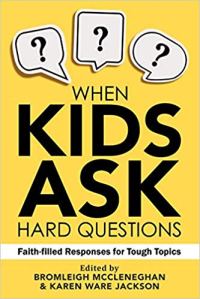 leaders from various backgrounds. They cover their own experience with telling their children about grief, racism, or sexuality, among other topics. At the end of each essay, there is additional advice on how to have the conversations in question and other recommended resources. I immediately bought this book for a theological student with whom I work and I cannot recommend it highly enough as a resource for any pastor, youth and family worker, or parent raising children in faith.
leaders from various backgrounds. They cover their own experience with telling their children about grief, racism, or sexuality, among other topics. At the end of each essay, there is additional advice on how to have the conversations in question and other recommended resources. I immediately bought this book for a theological student with whom I work and I cannot recommend it highly enough as a resource for any pastor, youth and family worker, or parent raising children in faith.
 This book is about a cholera epidemic in 1854 and the effort to figure out its source and how to stop it. My husband refers to it as the story when “cartography saved the day”. It’s more than that, though, as it covers the class struggle in London at the time and the idea, which still exists, that people living in poverty “deserve” death or struggle. The thing that will stick with me is how long the people who were wrong about infectious diseases, its spread, and causes persisted in in their wrongness. Even when the source of the cholera break was closed off and the illnesses stopped, some people still wanted to believe incorrect information about how people became ill and how illnesses are shared. When influential people persist in wrongness, especially scientific wrongs, innocent people die. This book is a warning about how that happens.
This book is about a cholera epidemic in 1854 and the effort to figure out its source and how to stop it. My husband refers to it as the story when “cartography saved the day”. It’s more than that, though, as it covers the class struggle in London at the time and the idea, which still exists, that people living in poverty “deserve” death or struggle. The thing that will stick with me is how long the people who were wrong about infectious diseases, its spread, and causes persisted in in their wrongness. Even when the source of the cholera break was closed off and the illnesses stopped, some people still wanted to believe incorrect information about how people became ill and how illnesses are shared. When influential people persist in wrongness, especially scientific wrongs, innocent people die. This book is a warning about how that happens.
The Sun Does Shine: How I Found Life, Freedom, and Justice
 I listened to this book on a long drive between St. Paul, Minnesota and Big Timber, Montana. When I finished listening somewhere in eastern Montana, I wanted to get out and yell. (But it was about 9 degrees outside and I didn’t know how cathartic a shivery yell would be). If you read Just Mercy by Bryan Stevenson, this is the story of one of the men in that book. Anthony Ray Hinton served more than 30 years on death row in Alabama for a crime he didn’t commit. The state refused, consistently, to reexamine evidence in his case. The book, while detailing some of that process, is truly about Hinton’s efforts to keep his own spirits up, as well as that of his fellow incarcerated people. It’s a fascinating read (or listen) and I recommend it as an examination on what you think you know about those who are on death row, that experience, and how to forgive.
I listened to this book on a long drive between St. Paul, Minnesota and Big Timber, Montana. When I finished listening somewhere in eastern Montana, I wanted to get out and yell. (But it was about 9 degrees outside and I didn’t know how cathartic a shivery yell would be). If you read Just Mercy by Bryan Stevenson, this is the story of one of the men in that book. Anthony Ray Hinton served more than 30 years on death row in Alabama for a crime he didn’t commit. The state refused, consistently, to reexamine evidence in his case. The book, while detailing some of that process, is truly about Hinton’s efforts to keep his own spirits up, as well as that of his fellow incarcerated people. It’s a fascinating read (or listen) and I recommend it as an examination on what you think you know about those who are on death row, that experience, and how to forgive.
I don’t know how to describe this book. Imagine a world wherein women possess the ability to physically overpower men and then use that power to overtake the whole world, reshaping human history and the ideas about how men and women interact and the roles they are expected to have. It actually took me six weeks to finish this book because it is so intense and thought-provoking that I could only consider tiny bits at a time. The thing is, when you step away from the book- it is not that you end up rooting for women to have this power; it’s that you end up with a very stark picture of how absolute power corrupts absolutely.
 This is the third book in the Loyal League series by Alyssa Cole and I recommend them all. I listened to this book because I have resolved to listen to the audiobooks by and about people of color as often as possible. Listening such a book in the inflections or voicing of a person of a different race from me helps me to hear and perceive different things in the book itself. My interior voice is mine and contains my own locations and prejudices, intentional and unintentional. Listening to this book, with a Spanish speaking narrator, helped me to settle into the details of the book and hear nuance in places my eye might have skimmed. The conflict in this book between the two characters is resolved when one tells the truth to the other. With that resolution, the truth of the larger exterior conflict is lifted up and then becomes the real villain of the book. I really liked the male protagonist and I always enjoy Cole’s writing.
This is the third book in the Loyal League series by Alyssa Cole and I recommend them all. I listened to this book because I have resolved to listen to the audiobooks by and about people of color as often as possible. Listening such a book in the inflections or voicing of a person of a different race from me helps me to hear and perceive different things in the book itself. My interior voice is mine and contains my own locations and prejudices, intentional and unintentional. Listening to this book, with a Spanish speaking narrator, helped me to settle into the details of the book and hear nuance in places my eye might have skimmed. The conflict in this book between the two characters is resolved when one tells the truth to the other. With that resolution, the truth of the larger exterior conflict is lifted up and then becomes the real villain of the book. I really liked the male protagonist and I always enjoy Cole’s writing.
The Life-Changing Manga of Tidying Up
I know most people love Marie Kondo and they watch her show and they’ve read all her books and that’s great for them. I tried to read her book, but I couldn’t. In part because I have a disaster of a house and an office and her method seemed too overwhelming for me. Then, one day, I was standing in line at a bookstore and I saw the manga version of her book. I picked it up and then immediately knew it was for me. It covers the highlights of the original book. but in a graphic novel format. While it does have the folding recommendations, etc… the blessing of this format is that you get the main idea of Kondo’s method visually and in a few words. Most of us don’t use most of our stuff. Tidying up frees us and (theoretically) our things. There’s not likely any way that I’m ever going to own only 30 books, but I have taken to heart other messages from this book and I really recommend it to any other Kondo holdouts, like me.
know most people love Marie Kondo and they watch her show and they’ve read all her books and that’s great for them. I tried to read her book, but I couldn’t. In part because I have a disaster of a house and an office and her method seemed too overwhelming for me. Then, one day, I was standing in line at a bookstore and I saw the manga version of her book. I picked it up and then immediately knew it was for me. It covers the highlights of the original book. but in a graphic novel format. While it does have the folding recommendations, etc… the blessing of this format is that you get the main idea of Kondo’s method visually and in a few words. Most of us don’t use most of our stuff. Tidying up frees us and (theoretically) our things. There’s not likely any way that I’m ever going to own only 30 books, but I have taken to heart other messages from this book and I really recommend it to any other Kondo holdouts, like me.
This is a novel in two points of view. The modern framework is an American woman who served as a soldier in Afghanistan and is experiencing nearly debilitating PTSD. The historical framework is of a young woman who disguises herself to go fight in the Civil War on behalf of the Union. The stories are somewhat connected, but there is NOT time travel. The book touches on the ways war and fighting affects those who are in battle, those who are left behind, and how we all cope (or don’t) in the aftermath.
I read this book because I am obsessed with George Mallory and the 1924 attempt for the Everest summit. This novel flips between George and Ruth’s points of view. It covers weeks for George, but I think it’s really only covering Ruth’s life on 8-9 June 1924 when George died. (I’m sorry if that’s a 96-year-old spoiler.) I appreciated the amount of research that went into the book and the real discussion of Ruth’s emotions, as well as George’s. Tanis Rideout had to imagine what happened at the top of the mountain and I think her reflections are good and in keeping with what is known and unknown. She doesn’t make a dramatic leap and the book is better for it (even if I want to believe differently about what happened). This is probably the one book on this list wherein I don’t care if you read it or not, it was good for me.
 Americanized: Rebel Without a Green Card
Americanized: Rebel Without a Green Card
I reviewed this book here. I’ll quote myself:
This is a very relevant book for our time and it feels like it was written because of that. “Illegal” immigration status happens for a variety of reasons, even if the immigrant is doing his/her/their best to follow the rules and keep up with the paper trail.
Saedi’s book tells her own story of being an Iranian immigrant living an American teenage life. Her teen angst has a ghost partner that is the looming possibility of deportation and returning to a country she doesn’t know and that doesn’t know her.
Her smooth narrative style and humorous tone belies what must have been frightening and stressful at times for her parents, her sister, and other members of her family. We hear about Saedi’s boy struggles alongside the real drama of slow and frustrating experiences with the INS.
As I was reading the book, I wish I’d had a book club to read along with, but not one where we all agree. I wanted to fight about this book with someone and point out that this is not an unusual story- it’s a standard immigrant narrative and the US must learn how to understand this narrative as part of our own national story.
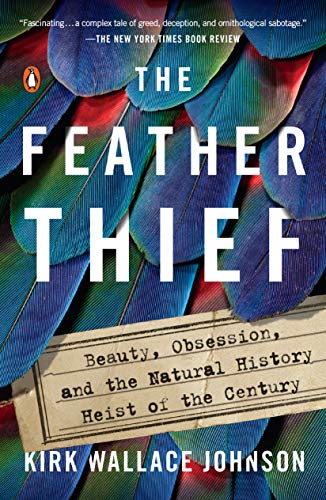 The Feather Thief: Beauty, Obsession, and the Natural Heist of the Century
The Feather Thief: Beauty, Obsession, and the Natural Heist of the Century
The whole time I listened to this book, I had to keep reminding myself that the crime occurred in 2009. The book isn’t just a tale in a theft of rare birds from a museum or of the secretive fly-tying community. This book covers privilege, access, and what science can do. It plays with the issues of who decides what happens to animals, to resources, and to the future of research. This is another book where I really needed someone else who read it because I really wanted to talk about it. My 9-year-old son was also riveted listening this book and made me stop it when he was dozing off in the car because he didn’t want to miss anything.
I actually listened to this book 4 times this year. It has one of the hottest sex scenes I’ve ever read. I loved the book, though, because the male protagonist is deaf. Occasionally in romance novels, the female protagonist may have a physical handicap of some sort. In historical romances, if men have physical disabilities- they are most often war wounds. Hardly any man is ever born with some sort of physical (or mental) deficit. The exceptions are VERY notable. Oliver (the male protagonist) has created some workarounds with his deafness, but it’s also a real and present aspect of who he is and how Christina has to interact with him. (Also the end of the book made me want to cheer, except I finished it on an airplane!)
 My Life as a Goddess: A Memoir Through (Un)Popular Culture
My Life as a Goddess: A Memoir Through (Un)Popular Culture
This essay collection is full of surprises. The essay on his father is worth the whole price of admission. Branum is not “just” funny; he’s deeply insightful on the experiences that have shaped him and on what has shaped contemporary American culture. Even typing this now makes me want to go back and read the book all over again. I think I also enjoy Branum’s use of language. I love anyone who plays with English and drops little trivia tidbits in their own story and he does. I don’t actually have a lot of experience with Branum outside of this book, but his writing has made me be sure to listen to every podcast he guests on- I don’t want to miss a thing he says.
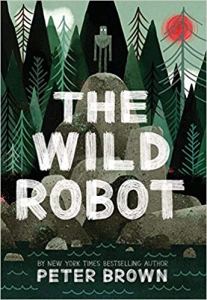 ** The Wild Robot and The Wild Robot Escapes
** The Wild Robot and The Wild Robot Escapes
Here is your bonus recommendation. I checked out the audio of the first book for my kids for a six hour drive to summer camp. That ride could not have gone any more quickly listening to that book. And I am grateful we finished before we got to camp or the kids might have refused to get out of the car until it was over. 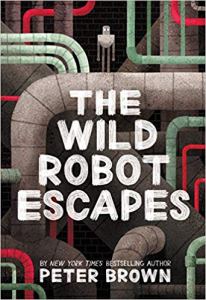 The premise of the first book is a shipwrecked robot whose adaptive AI helps her to communicate with animals on the island where she lands. The second book is about the interaction of people and robots and what it means to have “control”. The scene in the second book with the “Maker” is one of the most theologically provocative things I read all year.
The premise of the first book is a shipwrecked robot whose adaptive AI helps her to communicate with animals on the island where she lands. The second book is about the interaction of people and robots and what it means to have “control”. The scene in the second book with the “Maker” is one of the most theologically provocative things I read all year.
My kids still talk about these two books. We bought them AND we requested them for our library. For kids 7-11, these books are nearly sure fire. I promise.


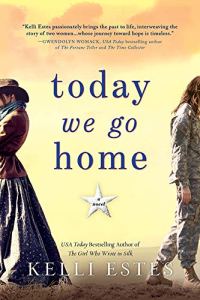


I also loved Burnout. That may be one of my top books for the year. Thanks for sharing these reviews!
LikeLike